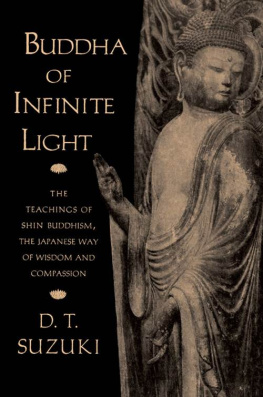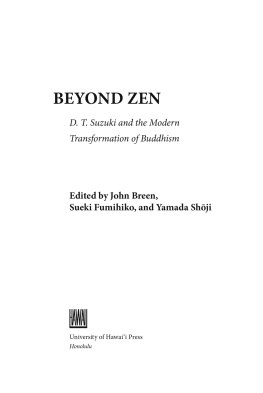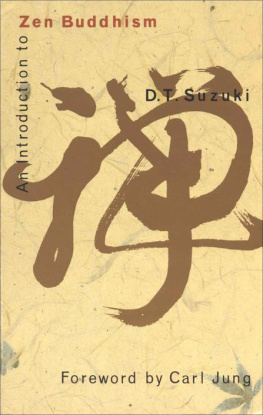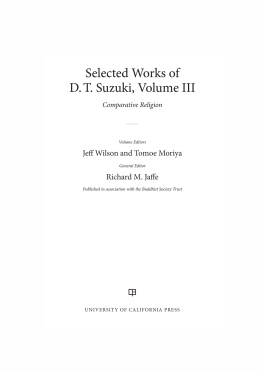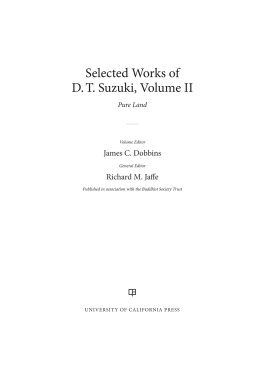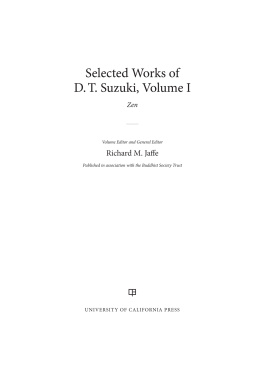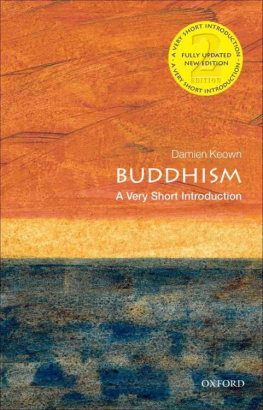ABOUT THE BOOK
Shin is the uniquely Japanese flowering of the type of Buddhism known as Pure Land. It originated in the thirteenth century with the charismatic and prophetic figure Shinran (11721263), whose interpretation of the traditional Pure Land teachings was extremely influential in his own lifetime and remain so today. In a period when Japanese Buddhism was dominated by an elitist monastic establishment, Shinrans Shin teaching became a way of liberation for all people, regardless of age, class, or gender.
Although Shin is one of Japans greatest religious contributionsand is still the most widely practiced form of Buddhism in Japanit remains little known in the West. In this book, based on several lectures he gave in the 1950s, D. T. Suzuki illuminates the deep meaning of Shin and its rich archetypal imagery, providing a scholarly and affectionate introduction to this sometimes misunderstood tradition of Buddhist practice.
DAISETSU TEITARO SUZUKI (18701966) was one of the primary modern interpreters of Zen for the West. He is the author of many books, among them Manual of Zen Buddhism, Essays in Zen Buddhism, and Zen in Japanese Culture.
Sign up to learn more about our books and receive special offers from Shambhala Publications.

Or visit us online to sign up at shambhala.com/eshambhala.
BUDDHA
OF INFINITE
LIGHT

D. T. Suzuki
Revised with an Introduction and Notes by
TAITETSU UNNO
JILL KER CONWAY PROFESSOR OF RELIGION AT SMITH COLLEGE
in association with
THE AMERICAN BUDDHIST ACADEMY

Shambhala Publications, Inc.
Horticultural Hall
300 Massachusetts Avenue
Boston, Massachusetts 02115
www.shambhala.com
1998 by The American Buddhist Academy
Cover art: Amida Looking Back . Reproduced courtesy of Zenrin-ji Temple, Kyoto, Japan.
All rights reserved. No part of this book may be reproduced in any form or by any means, electronic or mechanical, including photocopying, recording, or by any information storage and retrieval system, without permission in writing from the publisher.
The Library of Congress cataloged the previous edition of this book as follows:
Suzuki, Daisetz Teitaro, 18701966
Buddha of Infinite Light/ D.T. Suzuki; revised with an introduction and notes by Taitetsu Unno.
p. cm.
Rev. ed. of: Shin Buddhism.
eISBN 978-0-8348-2864-3
ISBN 1-57062-301-5
ISBN 1-57062-456-9 (pbk.)
1. Shin (Sect)Doctrines. 2. Pure Land BuddhismDoctrines.
I. Unno, Taitetsu, 1929. II. Suzuki, Daisetz Teitaro, 18701966. Shin Buddhism. III. Title.
BQ8718.7.S89 1998
CONTENTS


This work is a completely revised edition of Shin Buddhism by D. T. Suzuki, first published by Harper and Row in 1970. The book was a transcription of a talk given by Suzuki in 1958 at the American Buddhist Academy in New York City. It contains a Preface by the Reverend Hozen Seki, founder of the Academy and resident minister of the New York Buddhist Church.
Some editorial work was essential in preparing this new English edition, due to flaws in the transcription, vagaries in some sections, and confusion in the order of some paragraphs. Part of the confusion arose from the fact that Suzuki used the blackboard to explain some concepts. This, of course, appears in the audio recording as a disorganized, repetitive lecture. My revisions were aided immensely by the Japanese translation undertaken by Taira Sato and published in 1983 under the title Shinshu Nyumon by Shunjusha in Tokyo. Professor Sato prepared the translation by consulting the original tapes for chapters 1, 2, and 4 (none was found for chapters 3 and 5). His corrections and chapter subheadings have been incorporated into this new edition. I have also added an Introduction and Notes to provide a wider context for the main points made in the book. All this justified a new book title, Buddha of Infinite Light.
When D. T. Suzuki gave the lectures at the American Buddhist Academy, he was already eighty-eight years old and his audience probably had little or no knowledge of Pure Land Buddhism. I have tried to keep the unadorned style and informal nature of his talk. In spite of surface simplicity, the main teachings of Shin Buddhism are presented with sensitivity, clarity, and depth.
That this revised edition appears at this time is due to the efforts of several people working in concert. They include Hoken Seki and Brian Nagata of the American Buddhist Academy, Sam Bercholz of Shambhala Publications, and Wayne Yokoyama, who provided information on the Japanese translation. Credit is due to all of them for making this work possible.
TAITETSU UNNO
July 1, 1997

Where did I come from into this world?
Where am I going after death?
I CAME ALONE INTO THIS WORLD and am departing alone to the next world. If there were no compassion toward me from the Other-power, my past, present, and future would not exist. To protect and to guide me, there are countless powers. For examplemy parents, my society, my nation, the air, earth, sun, etc.all these powers of compassion are called Oya-sama. I cannot live in this world without Oya-sama. Oya-sama and I are in Oneness. Oya-sama is the infinite light and life that is called Amida Buddha.
In Japanese, Namu means myself. NAMU-AMIDA-BUTSU is an expression of onenessin other words, Oya-sama and I. Therefore when we recite NAMU-AMIDA-BUTSU it is an expression of gratitude for this universal compassion that is always within us and surrounding us, regardless of whether we recognize or accept it.
We came into this world with Oya-sama and will return to Oya-sama after our death. Oya-sama is the source of joy, hope, and gratefulness.
Dr. Daisetz Suzuki, the world-renowned Buddhist scholar, presented a series of lectures on Oya-sama, a Japanese expression of great compassion that is also the Shinshu teaching, the truth of naturalness. The five lectures were sponsored by the American Buddhist Academy and taped in the spring of 1958 at the main hall of the New York Buddhist Church.
My dear friends Mr. and Mrs. Robert Blickenderfer, who had never met Dr. Suzuki or heard his lectures, were anxious to hear the tapesthey were greatly impressed and decided to transcribe the taped lectures for publication, in order that others too may enjoy the immensity of Dr. Suzukis knowledge and wisdom on Buddhism.
Their great effort and patience have made this publication possible, for which I am deeply grateful.
THE REVEREND HOZEN SEKI
Founder, American Buddhist Academy
. This Preface was written in connection with an earlier version that did not have the benefit of Professor Unnos scholarship. The corrections made for this revised edition do not lessen the generosity or dedicated labor of the original transcribers.
Next page
